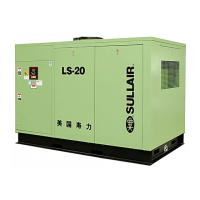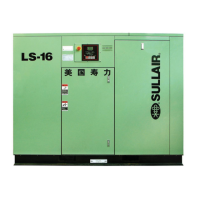Section 5
SUPERVISOR CONTROLLER
25
control. Select No for Load/No Load operation.
Unload pressure MUST be lowered to rated pres-
sure when using Load/No Load mode.
Language select - English, German, Spanish,
Italian and French may be selected for display lan-
guage.
Temp Units - Temperature units may be set to
degrees F or degrees C.
Press Units - Pressure units may be set to psi, bar,
or kPa.
5.6 MAINTENANCE - PREVENTIVE MAINTENANCE
INFORMATION AND TIMERS
The following lines are on the Maintenance display.
Information - The top two lines may be changed to
advise what to do when there is a maintenance
warning. For example a distributor can put in his
name and telephone number.
Ser. No - Serial number of machine.
Warn at - When the following drop below this
number, a warning is issued.
Oil Filter hours - Hours before oil filter change.
PN - Oil Filter part number.
Separator hours - Hours before separator
change.
Prim. - Primary separator part number.
Sec. - Secondary separator part num-
ber.
Air Filter hours - Hours before air filter
change.
Prim. - Primary air filter part number.
Sec. - Secondary air filter part number.
Oil hours - Hours before oil change.
PN - Oil part number.
Oil Anal. - Hours before oil analysis.
These hours and part numbers can be changed
using the enter and arrow keys.
Fault Log - Log of previous faults.
The fault log shows the last 16 faults that occurred.
The top line of the display shows the run hours
where the fault occurred, and the second line shows
the fault. The faults can be scrolled through using
the up and down arrow keys. They are ordered by
most recent first. (ie. when the function is entered
the most recent fault is displayed. Pressing the
down arrow displays the previous fault etc).
Sensor Log - Log of sensor readings leading up to
a fault.
The sensor log shows the sensor readings leading
up to a fault. The top line shows the last fault. The
following lines show T1, T2, P1 & P2. Each line rep-
resents readings that are 5 seconds apart for one
minute, then one minute apart for 10 minutes. There
is a second set of readings for T3, T4, P3 & P4.
5.7 SEQUENCING - SEQUENCING & COMMUNICA-
TION PARAMETERS
The following parameters can be viewed and edit-
ed. For more details on sequencing see the
Supervisor Sequencing and Protocol Manual.
Sequence By - Sequencing mode can be set to:
Disabled - Control does not do any sequenc-
ing.
Remote - Enables Remote Start/Stop, Remote
Load/Unload and Local/Master inputs
Hours - Uses the Seq Hrs parameter to deter
mine order of sequencing
Number - Uses the Com Number to determine
order of sequencing
Seq Hrs - This is an hour counter used when the
‘Sequence By’ parameter is set to ‘Hours’. Each
hour that the machine is running increments this
counter. When then ‘Sequence By’ parameter is set
to ‘Hours’, the machine with the least amount of Seq
Hrs is started first, and the machine with the most
Seq Hrs is shut off first.
Com Number - Communications number. When
two or more machines are connected together
using the network (RS-485 channel), each machine
must have a unique number or address. These
must be assigned in numerical order. For example
in a three machine system the machine communi-
cations numbers should be 1, 2 & 3.
Machines - This is the total number of machines
connected to the network (RS-485 channel). For
example in a three machine system, this parameter
should be set to 3. Up to sixteen machines may be
networked if all have Supervisor Controllers and
limited to eight if some have Supervisor II’s.
Low Press - This is the lowest pressure allowed
before immediately starting a machine.
Recovery Time - This parameter keeps multiple
machines from loading, unloading and starting at
the same time. For example if a low pressure con-
dition causes a machine to start, the next machine
will not start unless the Recovery Time has elapsed,
and the pressure has not recovered (i.e., has risen

